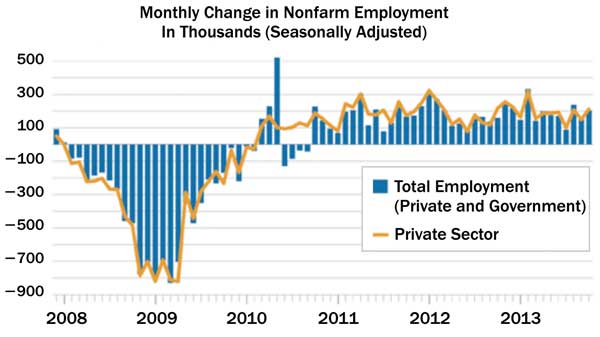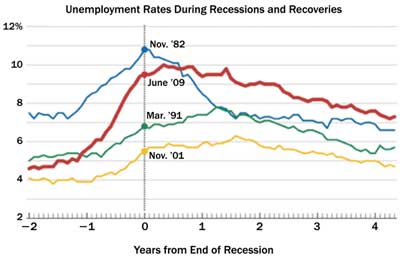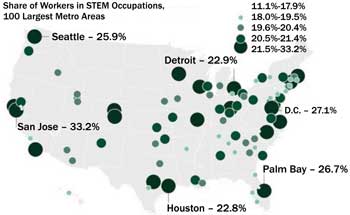Howard Rudzinsky, Rudzinsky Associates
As I contemplated today’s photonics job/employment environment, and the business climate and outlook for 2014, I went back to the “Where the Jobs Are” article I wrote for the August 2012 issue of Photonics Spectra. One difference between then and now, at least from an economic perspective, is that we’re simply further along in the economic recovery – but as we saw back then, job creation and job growth have continued to be slow/moderate. In fact, recovery this time around has been slower than that seen after several of the most recent recessions. As of October 2013, there were still 1.5 million fewer jobs than at the beginning of the recession in December 2007.
Economic outlook
The economy didn’t start adding jobs until early 2010, and we’re now at 44 months of continuous employment growth (Figure 1). Our “cup” (the left side of the graph), that is, 2008-2010, didn’t “runneth over” – it emptied out. And the resulting “stream” of job growth, to the right of the cup, is still short 1.5 million jobs. So, 44 months of continuous growth in employment is a good thing, but we still have a ways to go. To give you an idea of how bad this recession (and job loss) was, see Figure 2. This graph shows that we’re in the red in this recession, four years past the technical end of the recession in June 2009. Unemployment is higher than in the previous three recessions.

Figure 1. Employment is up again, but we still have a ways to go. Source: the Center on Budget and Policy Priorities, using data from the Bureau of Labor Statistics.
Other significant economic differences between 2012 and where we are as we head into 2014 include corporate profits, the US stock market and wages. Corporate profits are at some of the highest levels in history; the stock market (both the NASDAQ and the NYSE), the S&P 500 and other indexes seem to be hitting records daily, weekly, monthly. So, with profits so high, why don’t we all feel more prosperous? One answer is that wages as a percentage of gross domestic product (GDP) have fallen to lower levels. Companies are squeezing more profits out of fewer employees – helping their bottom lines, but not necessarily their employees’ wages and wealth. Our economy has seen more public companies retaining earnings for the balance sheet, for owners and stockholders; private companies are holding their money close to the vest, and corporate coffers are more flush with cash. We need creative ways to encourage companies to tap into this abundance to further everyone’s interests in photonics – firms, clients, employees and customers.
The answers aren’t so simple, but there are some truths that will help all of us in 2014 who are engaged in photonics, optics, lasers and the associated disciplines that we consider a part of our industry.

Figure 2. Rates of unemployment during recessions and recoveries from the 1980s to today. Source: the Center on Budget and Policy Priorities, using data from the Bureau of Labor Statistics.
The negative influences:
1. Wars and war fighting are winding down. The sequestration didn’t affect forces in the field as much as it is delaying acquisitions of major systems such as ships and aircraft. A total of $40 billion has been cut so far, and another $21 billion is scheduled for next year. For many defense-oriented optics/photonics firms, this means the need to find other places for their products that find their way into those platforms. It also means increased competition in the commercial optics space. Larger firms will have the advantage of being able to “buy” their way into commercial nondefense businesses by offering lower prices, sometimes at break-even or a small loss to keep their employees fully engaged.
2. Corporations that buy technology from photonics and other firms are holding onto their dollars longer. This includes enabling technologies such as optics and photonics, not just IT spending. Competition for sales is fierce and will remain that way going forward.
The positive influences:
1. Manufacturing is making a comeback in the US. The closely followed ISM manufacturing index increased for the sixth straight month, hitting a 2½-year high in November. Manufacturing helped lead us out of the Great Recession and helped fuel the jobs recovery in 2010. As the rest of the world’s economies revive, economic growth will accelerate into 2014.
2. Energy exploration: Development is booming in the US. Photonics must find ways into this booming market.
3. Corporate profits are at record highs, and there is cash to be spent on technology. A rising tide lifts all boats, and that includes the photonics boat! We just have to convince those holding the purse strings of the value proposition of photonic products.
What do these influences, both positive and negative, mean for optics and photonics firms’ employment and outlook? With business tighter and competition fiercer, we all need to look at how we add value to our firms and customers. This means that all of us should look at what we do as a value proposition to our customers. What value do we add to make what our customers do tangibly better, cheaper, faster or more cost-effective, or yielding in higher quality or higher efficiencies?
Companies will have various answers, of course. Some examples: An industrial fiber laser will enable higher manufacturing throughput in processing your automotive/medical/parts, resulting in lower costs; a vision system will help maintain higher quality levels and fewer rejects; an optical test instrument will be able to test, accept or reject components more reliably and faster, resulting in higher efficiencies and lower costs; some lasers will be used in increasing ways in the energy industry; or optical/photonic components could be delivered faster to customers, with less delay, keeping them more satisfied.
Too often, our industry has been focused (forgive the pun) on the next latest technological improvement. Science is great, but product-driven revenues pay the way to advance science and fund R&D. Purely research-driven organizations will always demand new lasers, photonic technologies and equipment, but will do so at slower, not faster, replacement rates.
This means that, to grow our industry further, new applications for photonic technologies must be found that enable product and cost advantages to customers who buy the technologies. As Mark Zediker, chief technology officer of Foro Energy in Littleton, Colo., said recently to me, “We’re finding new ways to do old things.” Foro is an emerging fiber laser technology company, using laser technology in the oil and gas industry. “Not just for exploration and development as a whole,” Zediker said, “but we’re improving their ability to accomplish things.” Laser technology is being brought to bear in a vital, well-established US industry – energy – where it hasn’t been used that way before. Foro grew 10 to 15 percent in 2013, but will be “growing substantially due to new programs in 2014,” Zediker said.
What’s the takeaway? Find ways to bring photonics to the energy industry in new ways, and you will find business. Another takeaway: Find ways to bring photonics into lower-tech industries, less glamorous products than, say, semiconductors or satellites, and you will find business if there is a “value proposition.”
In defense-driven photonics organizations, there is a veritable mixed bag. The sequestration and the subsequent defense cuts affected photonics industry leader II-VI in Saxonburg, Pa.: “II-VI has been hiring selectively for replacement as well as some strategic hiring for organic growth in key technical areas,” said David Wagner, vice president of human resources. “Overall head count is up at II-VI, but this is primarily due to a number of acquisitions II-VI consummated this year.” Looking ahead to 2014, he expects small-to-modest growth in employment.
Another defense-oriented company, Lockheed Martin, announced in November that it would cut 4000 jobs and close several plant locations. Since 2008, the company has cut 30,000 positions, about 20 percent of its global staff, reducing total employment to 116,000. But its stock was up 50 percent heading into December, according to CNNMoney.
Defense company AOA Xinetics of Cambridge, Mass., a unit of Northrop Grumman Corp., saw relatively steady employment in 2013. “We had some shrinkage in one business area/location, but that was offset by growth in another business area/location,” said Keri Gillespie, an HR business partner at AOA Xinetics. She said that business in 2014 will see “selective hiring in some growth areas, depending on a variety of factors, including new business initiatives.”
David Gentes, employment manager at MIT Lincoln Labs in Lexington, Mass., which does mostly government-/defense-oriented work, echoed Gillespie’s sentiments: “There is constrained hiring, but it’s active in pockets.”
What do these things indicate in the defense world? Cuts to war fighting and forced sequestration mean smaller defense budgets; that’s a reality. If you ask employers involved in unmanned defense systems – in ISR (intelligence, search, reconnaissance systems) – you will find continuing strong levels of business. This continues to represent opportunities for optics- and photonics-oriented firms.
Commercial-oriented optics firms are finding growth, although there is competition. Zygo hired in 2013 and expects to continue hiring in 2014, said John M. Stack, president of Zygo’s Optical Systems Div. in Middlefield, Conn. “There is a shortage of certain types of skilled engineers ... optical design engineers and optomechanical engineers, for example, especially with experience in product development. The overall business climate was such that the markets and areas where Zygo conducts business are moving in the right direction, following the economic recovery cycle.”
“Our bookings were trending up and continuing up in 2013,” said Dr. Stephen D. Fantone, president of Optikos Corp. in Wakefield, Mass., “and if they continue at this rate, Optikos could be up in excess of 25 to 30 percent in 2014.” Wayne Marchese, the company’s director of finance, echoed these sentiments, adding, “We are growing and adding staff, and the lack of staff in some areas is limiting our growth.” This is clearly positive.
Ami Doucet, senior manager of human resources in the Optics & Corporate Group at Newport Corp. in Irvine, Calif., said that in her area, “resulting from a new program, there was significant engineering hiring in 2013.” She said Newport will keep adding staff incrementally, as needed, in her business area in 2014.
For Opco Laboratory Inc., an optical components and assemblies manufacturer in Fitchburg, Mass., 2012 was a “banner year,” according to David Maldari, company president. “2013 continued with moderate growth, as we pursued new opportunities and added staff,” he added. For 2014, he is “very optimistic, as Opco continues to add and diversify its capabilities for its customers.” With respect to employment, the company is “adding staff, but we’re looking for employees with broader, more diverse skill sets.”
Advice for job seekers
Photonics as an engineering employment discipline comprises many roles: optics, physics, electrical, mechanical, software, solid-state and engineering skills as well as sales/marketing, manufacturing, quality and R&D. All require some level of “specialized” knowledge that is broadly defined as STEM (science, technology, engineering and mathematics ) disciplines/skills. STEM jobs represent 20 percent of all jobs in the US, and there are 26 million STEM jobs in total. Fifty percent do not require a bachelor’s degree. Working in optics, lasers and photonics, we all know that some of our most valuable human capital assets are the highly skilled technicians who put our devices and systems together, fabricate and test our optics, troubleshoot and repair them in the field.
Where are these STEM jobs? Figure 3 will give you a clue. As a photonics employee, are you positioned right, geographically, to maximize your potential?

Figure 3. Geographical overview of STEM job distribution in the US. Photo courtesy of Brookings Institution, http://tinyurl.com/qakluz3.
As an employee, what is your value proposition? What do you add to the process, the product, the bottom line? We all have to find a way to add value, from the factory floor to the corner office. Employees who bring more than one skill to the workplace will be sought after. There is always a need for a “super specialist,” but firms are increasingly hiring versatile individuals: the laser engineer who can program the robot on which the laser is mounted; the manufacturing engineer versed in “lean,” Six Sigma and statistical process control; the product manager well versed in product introduction processes and methodologies; the technical manager who also can participate in sales and present well to customers.
Can you help automate test equipment by having proficiency with Labview, Matlab or some other automation software, scripting or C language? Do your customers view your sales skills as a value-added partner, or as just a commodity seller/order taker? Even if you have a commodity-oriented product/component, you should position yourself as a value-adding partner. If you are in product management and marketing, are you using social media to promote your products, services and business? Do you understand Google Analytics/tools and SEO (search engine optimization)? You should. We all should be doing and understanding these things.
Having lived through one of the worst recessions for employment in our history, the photonics industry is growing – and poised for greater growth as our economy continues to recover, add jobs, grow manufacturing and continue gaining productivity. I am confident that 2014 will be a growth year for photonics overall. I also expect unemployment to continue to drop: At the time of this writing, in early December, unemployment had dropped to 7.0 percent from 7.3 percent, per the latest jobs report. It will drop to or below 6.5 percent at the end of 2014, and even further if economic growth picks up the pace. One strong sign is that the day I wrote this article, the third-quarter GDP was revised upward to 3.6 percent, a sign of stronger growth in the economy. This, coupled with the jobs report, is good news, trending better for all employed in photonics-related fields.
Meet the author
Howard Rudzinsky is president of Rudzinsky Associates in Arlington, Mass.; email: [email protected].
STEM in depth
The Brookings Institution offers a deeper look at STEM opportunities in a report titled “The Hidden STEM Economy,”
by Jonathan Rothwell. For more information, including useful infographics and detailed geographical breakdowns, visit http://tinyurl.com/nvvhrq5.